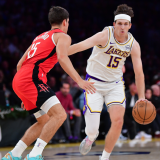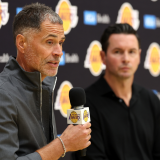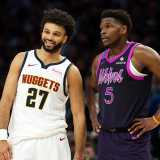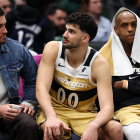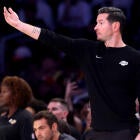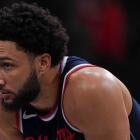
2013 Offseason Report: Toronto Raptors
CBSSports.com is taking a team-by-team look at the 2013 NBA offseason. We continue with the Eastern Conference hopefuls, the Toronto Raptors.

Over the next month, CBSSports.com's Eye On Basketball will take a team-by-team look at the 2013 NBA offseason. We continue with the Eastern Conference hopefuls, the Toronto Raptors. Check out the rest of the offseason reports here.
How they finished 2013
The Toronto Raptors didn't have the season many of us thought we'd see in 2012-13, and yet it was still surprisingly uplifting by the time the entire campaign was over. In 2010-11, Jay Triano coached the Raptors to a 22-60 record and the team had the worst defense in the NBA. They gave up 110.0 points per 100 possessions. Dwane Casey took over the sidelines and brought the defensive schemes and system that helped the Dallas Mavericks win the 2011 championship to Toronto, improving the team's defensive rating to 12th in the NBA at 101.5.
That kind of extreme improvement, especially when Aaron Gray is starting at center for 40 of the 66 games in 2011-12, left room for a lot of expectations heading into this past season. The Raptors were going to be one year deeper into the Dwane Casey School of Defense and Lithuanian prospect Jonas Valanciunas was coming over to the hedging, mobile center the system needed. But things didn't just improve like they were supposed to. The Raptors didn't move up; they moved backward... for a while.
The defense looked much worse and the offense wasn't good enough to make up for the drop on the other side of the floor. The team was faltering and they needed some kind of injection of life. Enter Bryan Colangelo and a trade of Jose Calderon, Ed Davis and a second round pick that netted them Rudy Gay from the Memphis Grizzlies. This was the moment the basketball online universe imploded.
Gay had been a disappointing scorer for the Grizzlies, primarily because he was struggling to make jump shots from the outside. He just flat-out couldn't shoot much anymore and the fit wasn't working with what the Grizzlies needed to do. They needed to play the game through their All-Star center and power forward, not their small forward whose jumper wouldn't find the net. And a change of scenery was pretty much exactly what Gay needed to at least start stretching his legs as a player.
Before Gay joined the team, the Raptors were 16-30 and nowhere near thinking about the playoffs. They were only scratching their heads, wondering why Andrea Bargnani didn't do more and Jonas Valanciunas didn't play more, and figuring out if the improvement in Dwane Casey's first year was just a fluke. After Gay joined Toronto, the team finished the season 18-18 and missed the playoffs by four games. It wasn't proof that the Raptors had finally figured it out, but they at least were a pain to deal with most nights.
Offseason needs
First and foremost, the Raptors needed new management. Even with the acquisition of Rudy Gay that gave the Raptors some new life, Bryan Colangelo had worn out his welcome. He had butchered the roster and the momentum of the team far too many times and the feeling in the front office was just incredibly stale, even when bringing in quality starters like Rudy Gay and Kyle Lowry.
Secondly, the Raptors needed a bit of 3-point shooting to improve on their percentage from last season. The Raps took the 12 most attempts on the year but had just the 26th best percentage. Or if you're a pessimist, they had the fifth worst at just 34.3 percent. Third, the Raptors needed some rebounding, as they seemed to get pounded on the boards most of last season. They finished 20th in the NBA in rebounding percentage.
The draft
Toronto traded their 2013 draft pick (along with Gary Forbes) to the Houston Rockets in order to bring in Kyle Lowry to be their starting point guard. It ended up in the hands of the Oklahoma City Thunder in the James Harden trade and they picked Steven Adams out of Pittsburgh with it.
Their second round pick was traded to the Memphis Grizzlies in the Rudy Gay trade and eventually became Jamaal Franklin out of San Diego State.
This was the easiest draft Toronto has had because they weren't involved at all.
Free agency and trades
The biggest move the Raptors made this offseason was getting rid of Bryan Colangelo from the basketball decision-making and bringing in 2013 NBA Executive of the Year Masai Ujiri. After Stephen Curry took a blowtorch to the Pepsi Center with the Denver Nuggets, the Nuggets effectively cleaned house by letting Masai Ujiri walk to Toronto on a big five-year deal and axing George Karl as he was heading into the last season of his deal. Ujiri's presence in Toronto instantly gave them one of the more confident front office executives in the NBA and he started shaping the rest of the front office to suit his plan.
Toronto then traded away former No. 1 pick Andrea Bargnani to the New York Knicks for Steve Novak, Marcus Camby (they bought him out), and Quentin Richardson. They also received a first round pick and two second round picks from the Knicks. Richardson won't be much of a factor, if at all, but the presence of Novak gives them some much-needed outside shooting.
After a strong summer league showing in Orlando, the Raptors signed undrafted point guard Dwight Buycks out of Marquette. The Raptors also signed Tyler Hansbrough away from the Indiana Pacers for a two-year deal and they grabbed Austin Daye on a two-year deal. Hansbrough fills a need for rebounding and Daye has been an inconsistent, but sometimes productive outside shooter.
Toronto also brought in D.J. Augustin as a backup point guard option on a one-year deal. However, his inability to make shots will probably end up putting Buycks ahead of him on the depth chart.
Overall grade and accomplishments: A-
Why did the Raptors get such a high grade from me when it looks like they didn't do much at all? Because they finally did some house cleaning that was probably long overdue. Yes, Colangelo did get them Rudy Gay and he could end up being a great perimeter weapon for them. Whether you think he's deserving of his contract or not, the team did find a way to play much better in the second half of the season with him. We don't know if that will continue into next year, but we've at least seen evidence that they can play better with him on the court.
The departures of Colangelo and Bargnani prove to the organization and the fans that the past won't be held onto any longer. Few executives are as aggressive and savvy in the trade market as Ujiri and with his scouting team in place, we could see this team turned around in a relatively short amount of time. You have to find a direction before you can start moving and it's easy to feel like Ujiri is good at finding direction for a team.
The moves to the roster were minor for the Raptors, but if we see them get back to the 2011-12 defensive effort and execution that brought about such nice expectations for the team coming into last season, they may not need to do a whole lot. DeMar DeRozan could stand to make more jumpers, Rudy Gay too. And while Jonas Valanciunas has gained some bulk to his frame and started playing more physical basketball against lesser competition, we still need to see that at the NBA level, in real NBA games to know he's ready to make the leap.
It's just good to see the Raptors can finally move into a new era of basketball without the old one glaring them in the face. Change isn't always fruitful, but it often can be very good.


